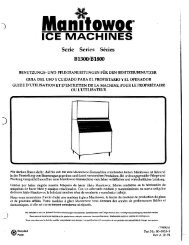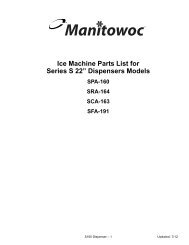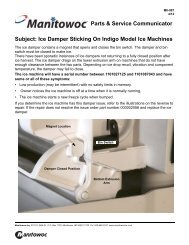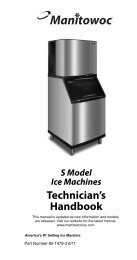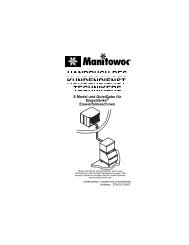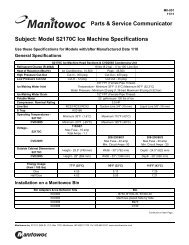S1800 Marine Model Ice Machines – Service Manual - Manitowoc Ice
S1800 Marine Model Ice Machines – Service Manual - Manitowoc Ice
S1800 Marine Model Ice Machines – Service Manual - Manitowoc Ice
Create successful ePaper yourself
Turn your PDF publications into a flip-book with our unique Google optimized e-Paper software.
Section 6 Electrical System<br />
PTCR DIAGNOSTICS<br />
What is a PTCR?<br />
A PTCR (or Positive Temperature Coefficient Resistor) is<br />
made from high-purity, semi-conducting ceramics.<br />
A PTCR is useful because of its resistance versus<br />
temperature characteristic. The PTCR has a low<br />
resistance over a wide (low) temperature range, but<br />
upon reaching a certain higher temperature, its<br />
resistance greatly increases, virtually stopping current<br />
flow. When the source of heat is removed, the PTCR<br />
returns to its initial base resistance.<br />
In severe duty cycles, it can be used to repeatedly<br />
switch (virtually stop) large currents at line voltages.<br />
PTCR’s have been used for many years in millions of<br />
HVAC applications. In place of using the conventional<br />
start relay/start capacitor, a simple PTCR provides the<br />
starting torque assistance to PSC (Permanent Split<br />
Capacitor) single-phase compressors, which can<br />
equalize pressures before starting.<br />
Compressor Start Sequence<br />
PTCR’s provide additional starting torque by increasing<br />
the current in the auxiliary (start) winding during starting.<br />
The PTCR is wired across the run capacitor (in series<br />
with the start winding).<br />
1. It is important for the refrigerant discharge and<br />
suction pressures to be somewhat equalized prior to<br />
the compressor starting. To assure equalization of<br />
pressures the harvest valve (and HPR valve on<br />
remotes) will energize for 45 seconds prior to<br />
compressor starting. The harvest valve (and HPR<br />
valve on remotes) remains on for an additional 5<br />
seconds while the compressor is starting.<br />
2. When starting the compressor, the contactor closes<br />
and the PTCR, which is at a low resistance value,<br />
allows high starting current to flow in the start<br />
winding.<br />
3. The current passing through the PTCR causes it to<br />
rapidly heat up, and after approximately .25-1<br />
second it abruptly “switches” to a very high<br />
resistance, virtually stopping current flow through it.<br />
4. At this point the motor is up to speed and all current<br />
going through the start winding will now pass<br />
through the run capacitor.<br />
5. The PTCR remains hot and at a high resistance as<br />
long as voltage remains on the circuit.<br />
6. It is important to provide time between compressor<br />
restarts to allow the PTCR to cool down to near its<br />
SV3158-6<br />
initial temperature (low resistance). When the<br />
contactor opens to stop the compressor, the PTCR<br />
cools down to its initial low resistance and is again<br />
ready to provide starting torque assistance. To<br />
assure the PTCR has cooled down, during an<br />
automatic shut-off, the S model ice machines have a<br />
built-in 3-minute off time before it can restart.<br />
Part Number 80-1634-3 6-15





